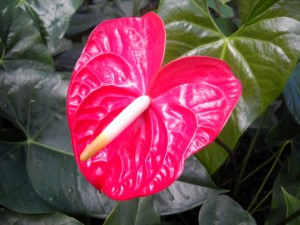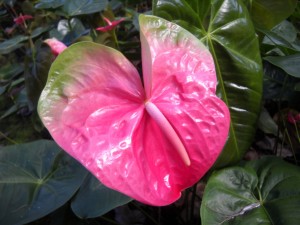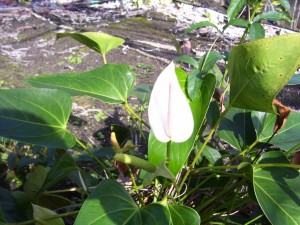Anthurium Species And Cultivars
There are many different anthurium species and cultivars. Many more are being discovered or created each year. This is my guide to the various species and cultivars.
Anthurium Andraeanum Cultivars
Waimea Anthurium
The Waimea is a red anthurium that was created to fill an important need. Red anthuriums are very popular flowers, but the foremost variety of red anthurium, the Ozaki, was decimated by a bacterial blight. The Waimea was created in response to this. It is a blight resistant variety that produces a lot of bright red flowers.
The Waimea was created back in 1987 by crossing Paradise Pink with a Marian Seefurth hydrid. The result was a fast growing plant that produced six flowers a year on average. The Waimea anthurium produces medium sized, heart shaped flowers with a red spathe and a spadix that changes from orange-red to red-purple. The flowers that it produces have a vase life of approximately 28 days.
Centennial Anthurium
The Centennial is a white anthurium that was named for the 100 year anniversary of higher education in the Hawaiian Islands. The Centennial has a lot of symbolic meaning for the University of Hawaii. It produces a white flower with green veins. White and green are the colors of the university. The veins merge together that the base of the flower and this represents the many diverse cultures that have come together at the university.
A lot of work went into the breeding of the Centennial. It is a hybrid that was made from four different species of anthurium: A. andraeanum, A. lindenianum, A. amnicola, and A. antioquiense. It produces a white tulip shaped flower with mild obake tendencies. It has a yellow-green spadix that turns white. As a plant it produces dark green leaves and many offshoots. It is great as a cut flower and as a potted plant.
New Era
The New Era is a purplish-pink anthurium that received its name by being the first blight resistant anthurium. It is ushering in a new era of blight tolerant anthuriums. It has a slightly elongated spathe and a yellow-green spadix that turns white as it matures.
The New Era was a result of crossing three different cultivars. An A494 Anthurium andraeanum was crossed with an A. antioquiense, and the result of this pairing was again crossed with a pink UH507 to produce this lovely flower. It has a long stem and is resistant to both bacterial blight and anthracnose. It was released to cooperating growers back in 2004 and it produces approximately 6 flowers per year. It also has an excellent vase life of 44 days.
Le’ahi
The Le’ahi is a pink and green obake that is named after the Hawaiian name for Diamond Head, the iconic volcanic cone that is a prominent Oahu landmark. The Le’ahi’s keeps its beautiful coloration year-round and produces almost 8 flowers a year. Unfortunately, it is susceptible to blight, so it is a slightly harder variety to grow.
The Le’ahi was created by mixing a child of orange-colored UH931 and a pink-colored Blushing Bride. It is a variety that works well as a potted plant and as a cut flower. Though as a cut flower, some say it has a stem that is a little too short. But its unusually beautiful color pattern, helps to offset its short stems.
Tropic Sunrise
The Tropic Sunrise is a large orange obake flower that was created back in 1981 by crossing an Anuenue with an Soga Orange. It produces a large flower that is orange in the middle and green at the edges that can grow up to one foot long. It has a yellow spadix that turns white as it matures.
The coloration and size of the Tropic Sunrise are its best attributes. It produces its flowers on strong stems that can be up to 30 inches long. Its flowers can last up to 27 days in a vase and the plant produces roughly 6 flowers per year. Testing has shown that it is a strong plant with a slight susceptibility to anthracnose.
White Lady
The White Lady is another amnicola based hybrid. It produces small white tulip shaped flowers that have a tendency to be a little longer than other tulip shaped species. It was created by crossing four different species, so it has quite a mixed heritage. It has small dark green leaves that are shaped like elongated spades. And it makes an excellent potted plant or cut flower.
As a cut flower, White Lady, has a vase life of 25 days. As its flowers age they can develop a pinkish hue, so they look great on potted plants. It is a great plant for growers and hobbyists because it is highly resistant to both anthracnose and blight. It yields approximately 6 flowers a year. The spadix on these flowers can grow to six inches long and their stems grow up to 22 inches. The spadix starts out yellow and changes to green as the flowers mature.
Hokuloa
The Hokuloa is a beautiful white anthurium. In Hawaiian, the word Hokuloa refers to the planet Venus, which is otherwise known as the morning star. It is a brilliant white flower that is worthy of its name. It comes in the standard heart shaped configuration and has a yellow spadix that changes to white as the flower matures. It produces medium five inch wide flowers on stems that are up to 27 inches. It is a hardy plant that is resistant to both blight and anthracnose, so it is relatively easy to grow.
The Hokuloa was created by breeding a Tropic Mist, which produces large cream colored flowers with selection 768-47, which is a hybrid of a Marian Seefurth and an A. antioquiense. This created a plant with glossy white flowers that are resistant to rain damage. It grows well in tissue culture and produces roughly 6 flowers per year. It has an excellent 37 day vase life, so it makes a great cut flower.
Hilo Moon
The Hilo Moon is another white anthurium with a celestial name. It is closely related to the Hokula and is in fact a sibling of it as they share the same parents. Sometimes, when you cross two plants, you get several child plants that are worth cultivating. Like actual siblings, you can see the resemblance, but they have their own unique qualities.
The Hilo Moon looks almost like the Hokuloa, except it is slightly less symmetrical. It is the same white color and it has the same yellow spadix that changes to white as the flower matures. It has a higher yield and can produce up to 8 flowers per year, but unfortunately its flowers have a shorter vase life, only 22 days, compared to 37 days. It shares a resistance to blight and anthracnose and it produces more offshoots than its sibling.
Anthurium Species
There are more than eight hundred species of anthurium plants in the world. But what is even more remarkable is that more species are being discovered each year. So the ultimate number of anthurium species may be much higher than eight hundred. Of these eight hundred species of anthurium, only four species are sold commercially. And these four species can be lumped into two categories: foliage or flowers.
Foliage Species
The two species grown for foliage are: Anthurium Crystallinum and Anthurium Faustinomirandae. A. Crystallinum normally produces large two foot long leaves. Its leaves have a smooth surface and dark green color that is punctuated by pale, white veins. While, A. Faustinomirandae has even larger green leaves that are very thick and sturdy. Its leaves can be up to five feet long.
Anthurium Scherzerianum
The first species grown for their flowers is Anthurium Scherzerianum. A. Scherzerianum is a plant that is very difficult to kill and hence it is a great choice for a novice anthurium grower. It produces a large number of flowers, but its flowers are not as impressive as the flowers produced by A. Andreanum. Usually its flowers are small, white and have a curly orange nose.
Anthurium Andraeanum
And the second species grown for flowers is Anthurium Andraeanum. Almost all of the flowers that you will see in a flower shop will be members of this species. Back in the 1940’s, Hawaii’s anthurium growers discovered that they could breed anthuriums selectively. This led to explosive growth in the number of varieties of anthurium flowers.
Anthurium Watermaliense
Anthurium Watermaliense gets its name from the town of Watermall, which is in Belgium. Watermall was the town where this plant was first taken after being collected in Columbia. It is also known as the “black anthurium”, though it really isn’t black. It produces flowers that are dark purple, which I suppose can be mistaken for black in the dim light of a jungle. The distinguishing characteristic of this species is a stipe, which other anthuriums do not possess. A stipe is a piece of stem that offsets the spadix from the spathe on these flowers. On other anthuriums, the spadix emerges directly from the spathe.
Anthurium Plowmanii
Anthurium Plowmanii is named after botanist Timothy Plowman, who has discovered and catalog a large number of plants from the Amazon. It grows in various parts of South America at elevations ranging from sea level to 3000 feet and it tolerates dry conditions much better than many other members of the anthurium family. It is sometimes called Anthurium Plowmanii Ruffles or Anthurium Fruffles, possibly because of the wavy shape of its leaves. It can grow to a decent size and grows in what is sometimes called bird’s nest form; if you use your imagination it kind of looks like a bird’s nest for perhaps a pterodactyl.
Anthurium Magnificum
Anthurium Magnificum is aptly named, it produces large and magnificent leaves. It’s olive green leaves with silver veins can grow up to two feet long and the surface of its leaves has a velvety texture. The main way to identify this species is to look at the petiole; members of this species possess square shaped petioles. In the wild, this species is only found in Columbia, but it is capable of growing in many other parts of the world. And many people grow it because of the beautiful leaves that it produces. It makes a great ornamental plant.
From their humble beginnings in Central and South American rain forests, anthurium plants have come a long way to Hawaii, and they haven’t stopped there. Now they are cultivated commercially in: Holland, Mauritius, Costa Rica and many other parts of the world. And they have a bright future as growers are continuing to breed incredible new varieties.
Anthurium Plants: How to Keep Them Alive
Anthurium plants are vulnerable to a number of diseases, pests and poor care practices, but overall they are really easy plants to care for. In this article I am going to give you guidelines that will help you to keep your anthurium plant in excellent shape. And of course I am also going to tell you the quickest way to kill an anthurium. This one common mistake is responsible for killing more anthurium plants than all of the other mistakes combined.
The Two Keys Of Anthurium Plant Care
The two most important components of anthurium care is choosing a good location to keep your plant and watering it properly. When it comes to location, temperature, light levels and humidity are all very important aspects. With watering, both too much and too little water can cause major problems. Everything else, including fertilizing, pruning, re-potting and even pest management is secondary. To learn more about these two critical items, please review my article on anthurium care.
Light Levels: A Commonly Overlooked Factor
Light levels are critical to anthurium plants. Too much light and your plants will burn. Too little light and your plants will be stunted. The key is to strike a good balance between these two extremes. In general, you should never put your anthurium in a location that receives strong, direct sunlight. The anthurium is a rain forest dwelling plant and requires weaker, filtered sunlight. You can accomplish this by keeping your plant near a window, but out of direct sunlight or you can put a thin, gauzy curtain over your window to block out a portion of the sun’s rays.
Anthurium Pests And Diseases
When it comes to pests and diseases, you will be pleased to know that if you are only raising a few indoor plants, the majority of the pests and diseases that plague anthurium plants that are grown in a commercial setting will be of no major consequence to you. Thrips, mites, nematodes, white flies and even the deadly Xanthomonas blight should be of little concern to you.
The main disease that you have to watch out for is root rot. This is caused by a fungus that thrives in moist, warm environments. Fortunately, it is easy to prevent this disease. All you have to do is pay attention to how you water your plant. Always make sure that all excess water is allowed to drain away from the roots of your plant and make sure that you wait for the roots to dry slightly before watering again. Assuming you are using a porous potting soil, you can water daily and still meet these two conditions. You can find more detailed information in my article on anthurium pests.
The Biggest Mistake
And finally the biggest mistake you can make with an anthurium plant is very simple and easy to do. I wish that this wasn’t the case, but this one mistake is responsible for killing more anthurium plants than all the other causes combined. And it is forgetting to water your anthurium plant. In the rain forest, these plants receive water on a daily basis. Obviously rain doesn’t fall in your home, so it is up to you to water them. I believe that the best way to remember to water them is to keep them in a location where you see them everyday and just make it a habit to water them everyday at the same time of the day. And remember, if you are watering them on a daily schedule; make sure you have them planted in a potting mix that drains well to avoid root rot.
Anthurium Plant Video
This is a brief video on how to care for a potted anthurium plants. It covers potting, watering and sunlight requirements.





